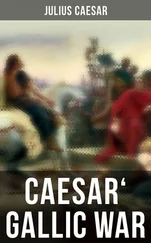Napoleon III - History of Julius Caesar Vol. 2 of 2
Здесь есть возможность читать онлайн «Napoleon III - History of Julius Caesar Vol. 2 of 2» — ознакомительный отрывок электронной книги совершенно бесплатно, а после прочтения отрывка купить полную версию. В некоторых случаях можно слушать аудио, скачать через торрент в формате fb2 и присутствует краткое содержание. Жанр: foreign_antique, foreign_prose, Биографии и Мемуары, на английском языке. Описание произведения, (предисловие) а так же отзывы посетителей доступны на портале библиотеки ЛибКат.
- Название:History of Julius Caesar Vol. 2 of 2
- Автор:
- Жанр:
- Год:неизвестен
- ISBN:нет данных
- Рейтинг книги:4 / 5. Голосов: 1
-
Избранное:Добавить в избранное
- Отзывы:
-
Ваша оценка:
- 80
- 1
- 2
- 3
- 4
- 5
History of Julius Caesar Vol. 2 of 2: краткое содержание, описание и аннотация
Предлагаем к чтению аннотацию, описание, краткое содержание или предисловие (зависит от того, что написал сам автор книги «History of Julius Caesar Vol. 2 of 2»). Если вы не нашли необходимую информацию о книге — напишите в комментариях, мы постараемся отыскать её.
History of Julius Caesar Vol. 2 of 2 — читать онлайн ознакомительный отрывок
Ниже представлен текст книги, разбитый по страницам. Система сохранения места последней прочитанной страницы, позволяет с удобством читать онлайн бесплатно книгу «History of Julius Caesar Vol. 2 of 2», без необходимости каждый раз заново искать на чём Вы остановились. Поставьте закладку, и сможете в любой момент перейти на страницу, на которой закончили чтение.
Интервал:
Закладка:
First Passage of the Rhine.
III. After so brilliant a success, Cæsar, to secure the results, considered it a measure of importance to cross the Rhine, and so seek the Germans in their homes. For this purpose, he must choose the point of passage where the right bank was inhabited by a friendly people, the Ubii. The study of this and the following campaigns leads us to believe that this was Bonn. 307From the field of battle, then, he proceeded up the valley of the Rhine; he followed a direction indicated by the following localities: Gueldres, Crefeld, Neuss, Cologne, and Bonn. ( See Plate 14. ) Above all, it was Cæsar’s intention to put a stop to the rage of the Germans for invading Gaul, to inspire them with fears for their own safety, and to prove to them that the Roman army dared and could cross a great river. He had, moreover, a plausible motive for penetrating into Germany – the refusal of the Sicambri to deliver up to him the cavalry of the Usipetes and Tencteri, who had taken refuge among them after the battle. The Sicambri had replied to his demand, that the empire of the Roman people ended with the Rhine, and that beyond it Cæsar had no further claims. At the same time, the Ubii, who alone of the peoples beyond the Rhine had sought his alliance, claimed his protection against the Suevi, who were threatening them more seriously than ever. It would be a sufficient guarantee for their safety, they said, to show himself on the right bank of the Rhine, so great was the renown of the Roman army among even the most remote of the German nations, since the defeat of Ariovistus and the recent victory; and they offered him boats for passing the river. Cæsar declined this offer. It did not appear to him worthy of the dignity of himself or of the Roman people to have recourse to barbarians, and he judged it unsafe to transport the army in boats. Therefore, in spite of the obstacles presented by a wide, deep, and rapid river, he decided on throwing a bridge across it.
It was the first time that a regular army attempted to cross the Rhine. The bridge was constructed in the following manner. ( See Plate 15. ) Two trees (probably in their rough state), a foot and a half in thickness, cut to a point at one of their extremities, and of a length proportionate to the depth of the river, were bound together with cross-beams at intervals of two feet from each other; let down into the water, and stuck into the ground by means of machines placed in boats coupled together, they were driven in by blows of a rammer, not vertically, like ordinary piles, but obliquely, giving them an inclination in the direction of the current. Opposite them, and at a distance of forty feet below, another couple of piles were placed, arranged in the same manner, but inclined in a contrary direction, in order to resist the violence of the river. In the interval left between the two piles of each couple, a great beam was lodged, called the head-piece , of two feet square; these two couples ( hæc utraque ) were bound together on each side, beginning from the upper extremity, by two wooden ties ( fibulæ ), so that they could neither draw from nor towards each other, and presented, according to the “Commentaries,” a whole of a solidity so great, that the force of the water, so far from injuring it, bound all its parts tighter together. 308This system formed one row of piles of the bridge; and as many of them were established as were required by the breadth of the river. The Rhine at Bonn being about 430 mètres wide, the bridge must have been composed of fifty-six arches, supposing each of these to have been twenty-six Roman feet in length (7·70 mètres). Consequently, there were fifty-four rows of piles. The floor was formed of planks reaching from one head-piece to the other, on which were placed transversely smaller planks, which were covered with hurdles. Besides this, they drove in obliquely, below each row of piles, a pile which, placed in form of a buttress ( quæ pro ariete subjectæ ), and bound in with it, increased the resistance to the current. Other piles were similarly driven in at a little distance above the rows of piles, so as to form stockades, intended to stop trunks of trees and boats which the barbarians might have thrown down in order to break the bridge.
These works were completed in ten days, including the time employed for the transport of the materials. Cæsar crossed the river with his army, left a strong guard at each extremity of the bridge, and marched towards the territory of the Sicambri, proceeding, no doubt, up the valley of the Sieg and the Agger, ( See Plate 14. ) During his march, deputies from different peoples came to solicit his alliance. He gave them a friendly reception, and exacted hostages. As to the Sicambri, at the beginning of the erection of the bridge, they had fled to the deserts and forests, terrified by the reports of the Usipetes and Tencteri, who had taken refuge among them.
Cæsar remained only eighteen days beyond the Rhine. During this time he ravaged the territory of the Sicambri, returned to that of the Ubii, and promised them succour if they were attacked by the Suevi. The latter having withdrawn to the centre of their country, he renounced the prospect of combating them, and considered that he had thus accomplished his design.
It is evident, from what precedes, that Cæsar’s aim was not to make the conquest of Germany, but to strike a great blow which should disgust the barbarians with their frequent excursions across the Rhine. No doubt he hoped to meet with the Suevi, and give them battle; but learning that they had assembled at a great distance from the Rhine, he thought it more prudent not to venture into an unknown country covered with forests, but returned into Gaul, and caused the bridge to be broken.
It was not enough for Cæsar to have intimidated the Germans; he formed a still bolder project, that of crossing the sea, to go and demand a reckoning of the Britons for the succour which, in almost all his wars, and particularly in that of the Veneti, they had sent to the Gauls. 309
Description of Britain in the time of Cæsar.
IV. The Romans had but imperfect information relating to Britain, which they owed to certain Greek writers, such as Pytheas of Marseilles, who had visited the Northern Sea in the fourth century before our era, and Timæus of Tauromenium. The Gauls who visited Britain for the sake of traffic, knew hardly more than the southern and south-eastern coasts. Nevertheless, a short time before the arrival of the Romans, one of the populations of Belgic Gaul, the Suessiones, then governed by Divitiacus, had extended their domination into this island. 310
It was only after having landed in Britain that Cæsar was able to form a tolerably exact idea of its form and extent. “Britain,” he says, “has the form of a triangle, the base of which, about 500 miles in extent, faces Gaul. The side which faces Spain, that is, the west, presents a length of about 700 miles. In this direction the island is separated from Hibernia ( Ireland ) by an arm of the sea, the breadth of which is apparently the same as the arm of the sea which separates Britain from Gaul;” and he adds that “the surface of Hibernia represents about one half the surface of Britain. The third part of the triangle formed by this latter island is eastward turned to the north, and 800 miles long; it faces no land; only one of the angles of this side looks towards Germany.” 311These imperfect estimates, which were to give place in the following century to others less inaccurate, 312led the great captain to ascribe to the whole of Britain twenty times 100,000 paces in circuit. He further gathered some information still more vague on the small islands in the vicinity of Britain. “One of them,” he writes, “is called Mona ( the Isle of Man ), and is situated in the middle of the strait which separates Britain from Hibernia.” The Hebrides, the Shetland islands ( Acmodæ of the ancients), and the Orcades, which were only known to the Romans at the commencement of our era, 313were confounded, in the minds of Cæsar and his contemporaries, with the archipelago of the Feroe isles and Scandinavia. Caledonia ( Scotland ) appeared only in an obscure distance.
Читать дальшеИнтервал:
Закладка:
Похожие книги на «History of Julius Caesar Vol. 2 of 2»
Представляем Вашему вниманию похожие книги на «History of Julius Caesar Vol. 2 of 2» списком для выбора. Мы отобрали схожую по названию и смыслу литературу в надежде предоставить читателям больше вариантов отыскать новые, интересные, ещё непрочитанные произведения.
Обсуждение, отзывы о книге «History of Julius Caesar Vol. 2 of 2» и просто собственные мнения читателей. Оставьте ваши комментарии, напишите, что Вы думаете о произведении, его смысле или главных героях. Укажите что конкретно понравилось, а что нет, и почему Вы так считаете.












